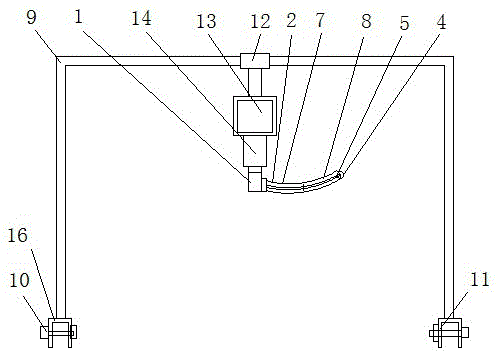[0003] In indirect laryngoscopy surgery, during surgery, the operator holds an indirect laryngoscope in one hand and a laryngeal forceps in the other. The principle is to use the
mirror reflection of light to
expose the
glottis in the mirror for the operator to perform surgery. Its
disadvantage is that when the laryngoscope and laryngeal forceps are respectively inserted into the
larynx in sequence, it is easy to cause secondary damage to the patient's
tracheal wall, and it is easy to cause diseased tissue
[0004] Supporting laryngoscope surgery, which is a surgery for vocal cord polypectomy under a
microscope directly looking at the supporting laryngoscope, is a traditional surgical method that has been used to this day. The supporting laryngoscope used in the operation includes a laryngoscope and a laryngeal forceps. The
handle and the straight lumen connected at right angles to the
handle, the upper end of the
handle is connected to the support bracket, the middle of the straight lumen is a cavity, the middle of the front end of the straight lumen is a steel direct laryngoscope, and the laryngeal forceps are composed of a forceps handle, and a forceps The clamp body connected by the handle and the scissors placed at the front end of the clamp body are composed. During the operation, the patient needs to lie flat and put shoulder pads on the back so that the mouth,
pharynx, and
larynx are on the same straight line before inserting the front end of the
straight tube cavity. For the larynx, select a laryngeal forceps with suitable scissors as needed, pass the body of the laryngeal forceps from the rear end of the straight lumen to the front end of the straight lumen, and perform direct surgery on the fixed and exposed vocal cords The
disadvantage is that the laryngoscope has no magnifying effect, and it is difficult to distinguish the
lesion range for more complex vocal cord polyps, and it is easy to remove too much, damage the vocal cord muscles and cause postoperative glottic insufficiency, aggravate hoarseness symptoms, or incomplete removal, The basal part remains and it is easy to relapse. Therefore, at present, a
surgical microscope is added to the supporting laryngoscope for operation. The position of the
microscope is to make the lens look directly at the affected part through the cavity in the
straight tube cavity. Therefore, the cost of surgical instruments At the same time, because the operation required by the microscope is far away, and is limited by the size of the cavity in the straight lumen of the laryngoscope, in addition, the laryngeal forceps used for surgery occupy part of the space in the cavity, so the operation is as simple as The
exposure is still not ideal, and in order to obtain complete glottic
exposure in some patients, the operator often inserts and tightens the support frame of the support laryngoscope as much as possible when placing the support laryngoscope, so as to maximize the
exposure, but it often affects the laryngoscope. Corresponding
crush injury in the lower part of the body, and the tension of the vocal cords becomes larger, and the excessive tension of the vocal cord edge of patients with vocal cord polyps is not conducive to surgery
In addition, some patients have thick and short necks, curled
epiglottis, changes in the curvature of the
cervical spine, hyperosteogeny, protruding
dentition, and high laryngeal body, which make it difficult to
expose the
glottis after inserting a supporting laryngoscope. Therefore, the root cannot complete the operation and the time cannot be extended
At the same time, since the
straight tube laryngoscope requires three points and one line at the mouth,
pharynx, and larynx during use, the disadvantages of this structure are: first, the compression of the straight tube lumen will affect the patient's palatal arch, tonsils, incisors and Contusions at the root of the tongue can cause bleeding, infection, loose teeth, and damage to the tongue nerve in severe cases, resulting in postoperative numbness in the mouth, loss of tongue taste and
sensation, and
tongue movement disorders. Polyps, after the straight tube is inserted, the thick straight tube will stretch the muscles of the throat wall, and it is easy to remove too much, which will damage the vocal cord muscles and cause postoperative glottic insufficiency, which will aggravate the symptoms of hoarseness
[0005] In order to solve the above-mentioned technical problems, CN201310194236 discloses an arc-shaped supporting laryngoscope surgical instrument, whose straight lumen is arc-shaped, although the first technical problem is solved, but in the process of inserting the trachea, due to the need
Throat forceps and scissors are inserted at the same time, resulting in a large
diameter of the front end of the surgical instrument, which is not conducive to rapid insertion and prolongs the
operation time. Moreover, during the insertion process, the muscles of the throat wall will be damaged, causing secondary injuries to the patient.
 Login to View More
Login to View More  Login to View More
Login to View More 


